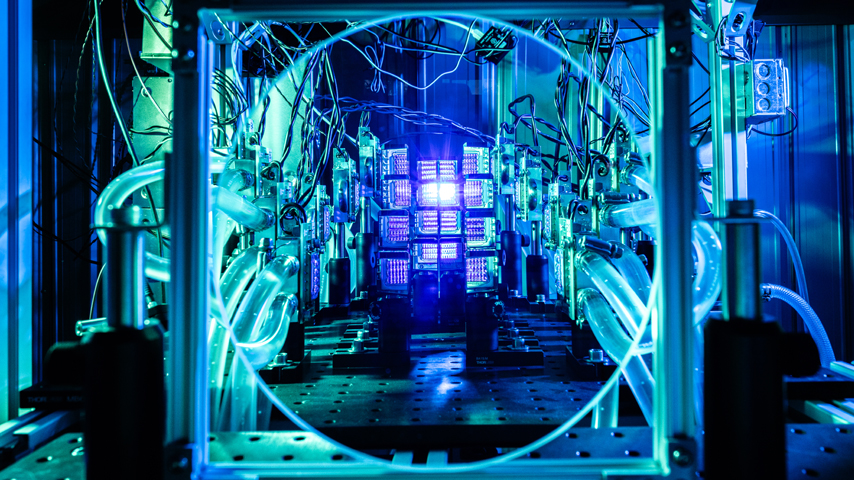Using Lasers to Produce Green Steel
Using Lasers to Produce Green Steel


Innovators are devising new processes to decarbonize the crucial alloy humanity can’t live without.
The following is an excerpt from the January 2025 Mechanical Engineering article, “In Pursuit of Green Steel.” The fully digital issue is available to ASME members at magazine.asme.org.
The 20th century was the Age of Steel. Its defining skyscrapers and suspension bridges, its fleets of automobiles and tanks, its household appliances, cargo containers—even components of the machines that took humans to the moon—were made of the material. And crude steel production exploded to meet that demand, increasing from 28 million metric tons in 1900 to 191 million metric tons in 1950 to 850 million metric tons in 2000.
And yet, for all the emphasis of emerging digital technologies with its use of optical fiber, silicon chips, and highly engineered polymers, steel consumption hasn’t slowed. In 2023, the world cumulatively produced about 1,849.7 million metric tons of crude steel.
According to the International Energy Agency, the production of one ton of steel creates 1.8 tons of carbon dioxide emissions. The steel industry as a whole is responsible for producing anywhere from 7 percent to 11 percent of the world’s carbon emissions. The exact figure depends on what you include, explained Hilary Lewis, steel director at Industrious Labs, an environmental organization that works to develop more sustainable steel production technology. “The 11 percent includes methane emissions to make coke from coal,” Lewis said.
In the Industrial Age, steelmaking advanced through the use of blast furnaces to melt the iron ore, coke, and limestone (to remove impurities from the ore) while blasting in hot air. “Those run on coal, they started running on coal, and they run on coal today,” said Kaitlyn Ramirez at RMI, (formerly Rocky Mountain Institute), a think tank that works to decarbonize the global energy system. “This traditional steelmaking with the blast furnace is very emission-intensive, as well as producing many other pollutants that impact air quality,” Ramirez said.
While blast furnaces start with iron ore, a lot of steel today is recycled and remelted, a process which requires less energy and emits fewer greenhouse gases. The recycled steel, which comes from construction scraps, cars, appliances, and other sources, is melted inside electric arc furnaces, skipping the reduction step. Worldwide, only 30 percent of steel comes from electric arc furnaces, though that fraction rises to 70 percent in the United States. While in theory steel is infinitely recyclable, recycling scrap steel can’t meet a demand that is growing the way current demand is.
Laser power
Startups are looking at using alternatives to carbon for making new steel. Hydrogen and electricity have been tested, but they are not the only carbon-free methods that can break iron and oxygen bonds. Lasers, which emit a coherent beam of energy-carrying photons, can do so too. That’s the concept that Olivia Dippo, co-founder of Limelight Steel, came up with while working on her doctorate in material science and engineering at University of California, San Diego.“We were using a couple of different types of lasers to heat materials and 3D-print objects with it,” Dippo said. “And I started thinking about what other technologies can we apply this to.”
Her collaborator, also a doctoral student then, thought the steel industry could use some lasers.
It’s an unexpected turn. While lasers have a fearsome reputation in science fiction, for decades, experts viewed lasers as inefficient tools that belonged to academic labs rather than industry. But that has changed as the technology came of age, Dippo said.
“Lasers are powerful, they’re becoming more efficient, and they can operate on a lot of different material systems that I think people haven’t necessarily thought of before.”
Although Limelight Steel has received $2.9 million from the U.S. Department of Energy, the company is still in the research and development stage and is operating at small scale.
“We are in the tens of grams range right now,” Dippo said, but the company has very ambitious goals and is already erecting a facility in Oakland, Calif. “We’re building a pilot which will be in the 100 tons a year range, and then we’ll build a demonstration plant, and then we’ll be at commercial scale, probably by 2030.”
The industrial plant will have a continuous feeding mechanism channeling the iron ore into the reactor and taping the liquid iron out as it melts. Dippo estimated that the method can cut about 70 percent of emissions.
Of course, those emissions reductions depend on a supply of zero-carbon electricity to run the lasers. While some industrial sector emissions are more intractable, the challenge in steelmaking might well be met through the decarbonization of the electrical grid and the application of some clever solutions.
Lina Zeldovich is a science and technology writer based in Woodside, N.Y. Her most recent book, The Living Medicine: How a Lifesaving Cure Was Nearly Lost—and Why It Will Rescue Us When Antibiotics Fail, was published in October 2024.

ME is Fully Digital
ASME members can access Mechanical Engineering magazine in its new, enhanced digital format. Everything you love about ME, now everywhere you go.
